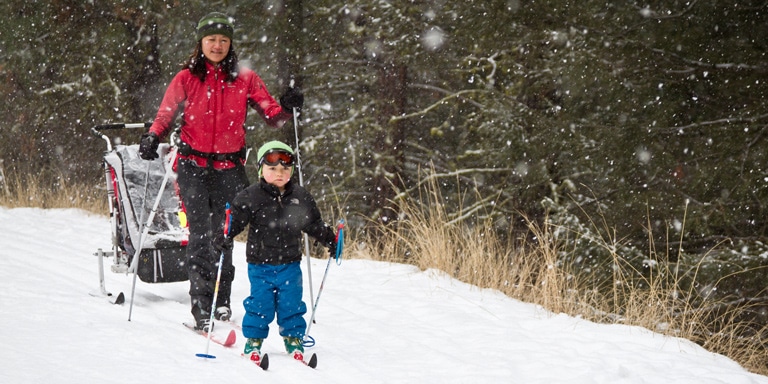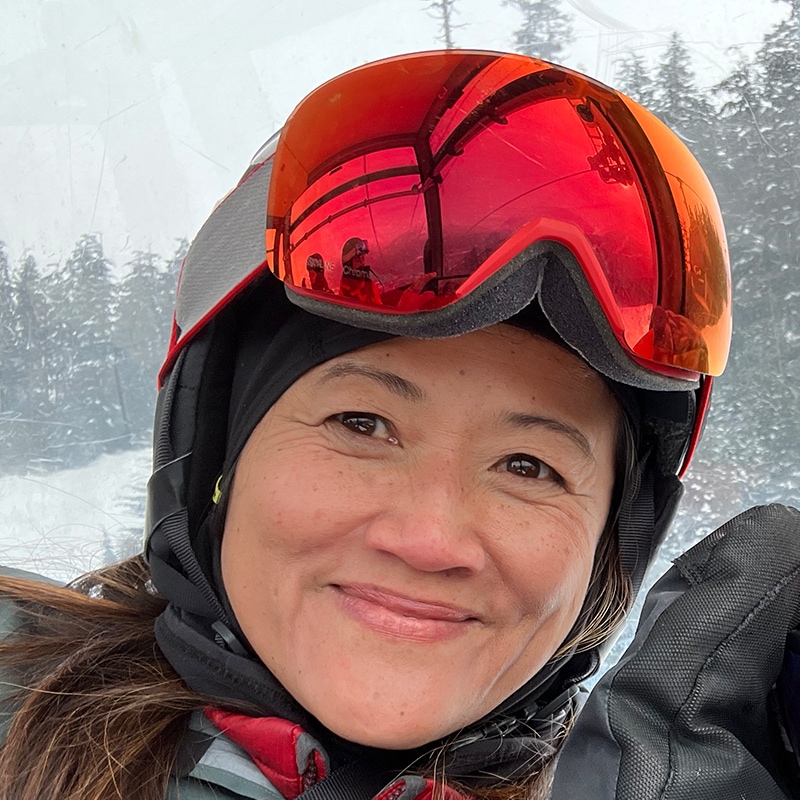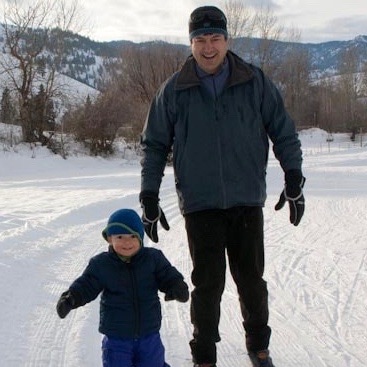You don't have to wait until your kids are older to strap on cross-country skis and get outside with them in the winter. Cross-country skiing with kids is a great way to get an aerobic workout while soaking in the snowy landscape as a family. Since my two sons were babies, I've been taking them on short cross-country ski adventures as well as longer hut-to-hut backcountry trips. The appeal? No long lift lines, fewer crowds, and it's less expensive than downhill skiing—so it's especially good for families to do together with young kids.
If you're interested in cross-country skiing with kids, this article will help you figure out:
- Ways to cross-country ski with kids
- How to start kids skiing on their own
- Tips for cross-country skiing as a family
In writing this article, I drew upon my own personal experiences taking my two kids cross-country skiing in places like Lake Tahoe, California, and the Methow Valley in Washington state. I talked with Kevin van Bueren, who grew up cross-country skiing in the Northwest, and is owner and ski school director of Methow Valley Ski School & Rentals in Mazama, Washington, where he has taught skiing since the mid-‘90's.
Ways to Cross-Country Ski with Kids
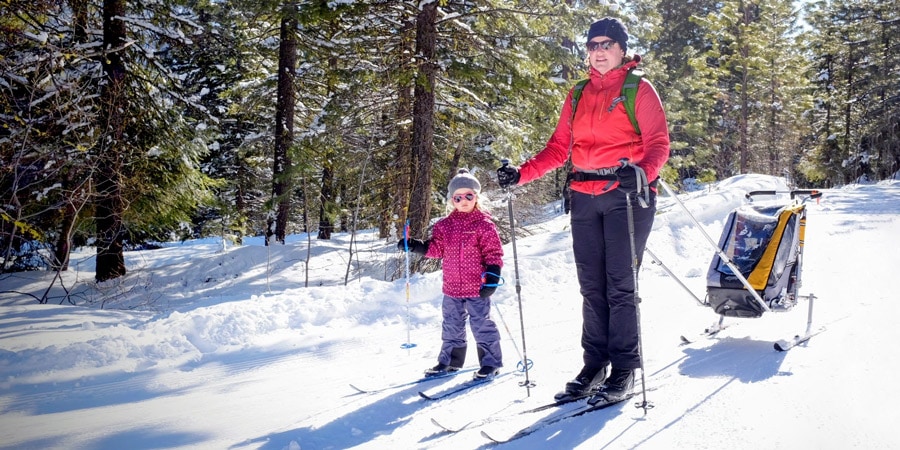
Ski trailers or pulks make it easy to take your young kids cross-country skiing with you. The sled you use will likely depend on what you can rent, borrow, buy or otherwise get your hands on. It's very important that you evaluate your skiing ability and experience, your fitness and the conditions before deciding whether to do it.
Cross-country skiing while towing a child in a sled or trailer:
- Ski trailers: Your child sits in a protective trailer that is connected to tow bars leading to a hip belt that you buckle around your waist. Manufacturers of joggers and bike trailers offer ski conversion kits, such as this one, that allow you to convert that bike trailer or jogging stroller into one that glides on snow. (The trailer or jogging stroller is mounted on skis rather than wheels.) Ski trailers keep kids protected from weather and debris and much warmer than they would be riding in a backpack. There's usually plenty of cargo space for snacks, extra clothing and lunch. But ski trailers cost a lot more.
- A pulk, or a sled, may have features such as an enclosed top, windshield, padded seat and safety harness or back rest. Two poles run from the sled to a hip belt that you secure around your waist to pull. These sleds typically have ridges on the bottom that ride on top of the snow (versus being up off the ground like ski trailers) so they can feel a bit heavier to pull. Try to insulate the seat underneath the child with a pad, blankets or a sleeping bag. Sleds without a protective cover leave kids more exposed to elements so bundle them up accordingly. Pulks are lightweight and less cumbersome to move around than a ski trailer and are more commonly available to rent at cross-country ski resorts.
When pulling a child in a pulk or trailer, keep these tips in mind:
- Consult with your pediatrician and check the manufacturer's recommendations for the age to start pulling your child in a sled. Be sure to read and follow the safety instructions in the product's user manual.
- Practice towing a loaded carrier while on skis before trying to tow your children. It takes time to get used to the added weight of the sled, especially when traveling uphill or downhill.
- Routinely check on your child to make sure they're comfortable and not too hot or cold. It helps to ski with another person so you have an extra hand. Learn more tips in our article How to Keep Babies Warm Outdoors.
- Do not leave your child unattended in the sled or carrier.
Tips to Get Kids Cross-Country Skiing on Their Own
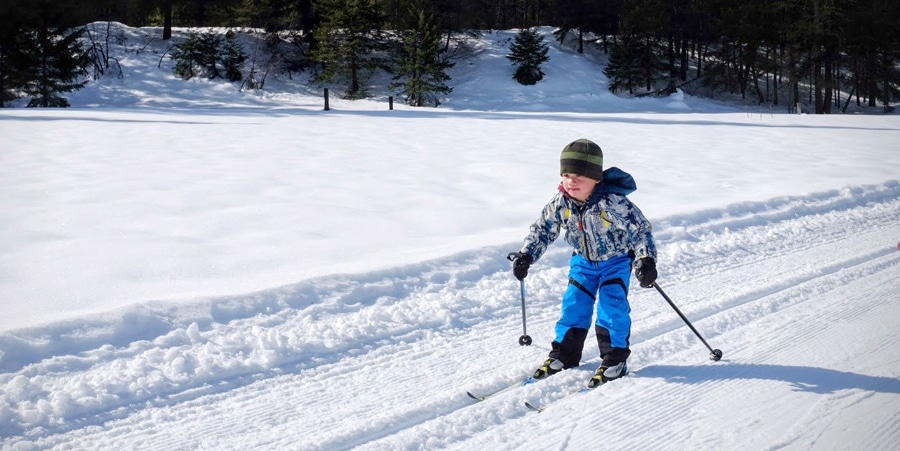
Once kids are too heavy to pull in a sled and can walk some distance on their own, it may be time to introduce them to cross-country skiing on their own. After watching you glide on skis, they'll probably want to copy you and try skis out for themselves. There's no right age to start kids cross-country skiing. Some can start as young as 5, shuffling on cross-country skis for very short distances. Many kids start out by learning the classic skiing technique because the movement is so similar to walking. To learn more about the differences between classic and skate skiing, read our Intro to Cross-Country Skiing article.
Take a lesson. It's always good to have a qualified instructor teach your child. The Cross Country Ski Areas Association provides a list of resorts that offer cross-country ski lessons. Some start teaching kids as young as 5. REI offers lessons in classic and skate technique for those 13 and up.
Before you get outside, have your child put on skis inside and try them out. Let them put on boots and experiment with clicking in and out of the skis. Have them practice shuffling along, preferably on carpet, while they hold your finger. Have them walk back and forth to get a feel for how the skis move. Guide them through a very slow turn, making tiny baby steps so they don't cross their tips.
Once outside, start them on two skis and let them walk. Hold your finger to the side so they have support if needed. If you're standing behind them, be careful not to let them lean back on you (when learning to ski, you want them to stay in a forward position). Hold a pole out in front of them so they can reach out for support if they need. Kids typically won't need poles until they're about 7 or 8.
Play games that reinforce their skills. One game that's fun: Take a snowball, throw it on the trail and have the child stomp on them with their skis. As they move toward the snowballs and then over them, they're learning to balance. Another game: Pitch a treat or sliced apple in front of them on the trail every 50 to 100 yards and have the kids ski over and reach down to pick them up (be sure you don't leave anything on the trail).
Tips for Getting Started
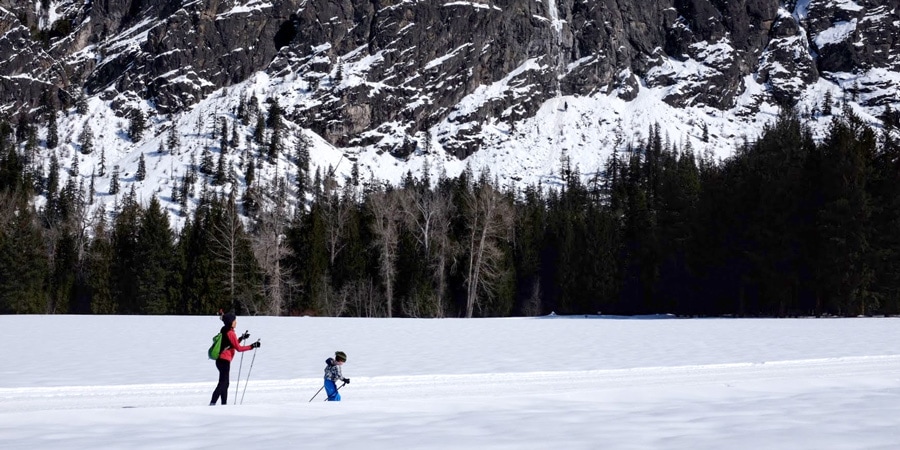
Pick your route carefully and make it an easy one. When taking your kids cross-country skiing, pick a route that is much easier than one you would typically ski on your own. You want them to have a successful time. You can always go multiple times on an easy loop.
Dial in gear ahead of time. Know how your equipment works so you're not scrambling with cold fingers and toes as you try to assemble the sled at the trailhead.
Keep trips short and stay close by if it's your first time out. Aim for an easy loop or a short trail that is close to the car, resort area or warm shelter. For younger kids, consider a 15-minute outing. If they're school-aged, maybe go out for 30 minutes to an hour.
Make it fun and all about the kids. If your kids are fussing or crying, click them out of their skis and call the day a success. Go back inside and take a break. (Hot chocolate solves most everything). Consider trying again another time that day.
Do what the child wants to do. Sharing your enthusiasm will help build a love and interest in the sport. You want your child to love cross-country skiing and everything that goes with it—and not to think of it as a trudge. Take breaks for snowball fights and other snow-play off trail. Stop to watch the rabbit or deer in the woods.
Time trips to younger kids' naps. The swish of skis and the gliding motion will often lull the littlest ones to sleep while you get your workout in.
Aim for the best weather of the day. The experience will be more enjoyable if you go when the weather is good and aim for the warmest time of day—typically between 10am to 1pm.
Take turns pulling. Everyone gets a workout if you share kid-hauling duties. That also gives time for the adult not pulling the trailer to ski at a faster pace or go on a quick solo jaunt.
Bring extra dry clothes: Dress the kids in warm layers and have extra dry gloves and clothes in case they get wet and cold. Learn more in our article on Tips for Dressing Your Kids in Winter.
Find groomed trails if possible: Groomed ski tracks help those starting out keep their skis straight. Many cross-country ski areas have warming huts and trails geared specifically for beginners. Find a cross-country ski area near you. Ask your local ski shop or ski professional for tips.
Editor's note: We reviewed this article on March 1, 2025 to ensure the information was up-to-date.
Related Articles
